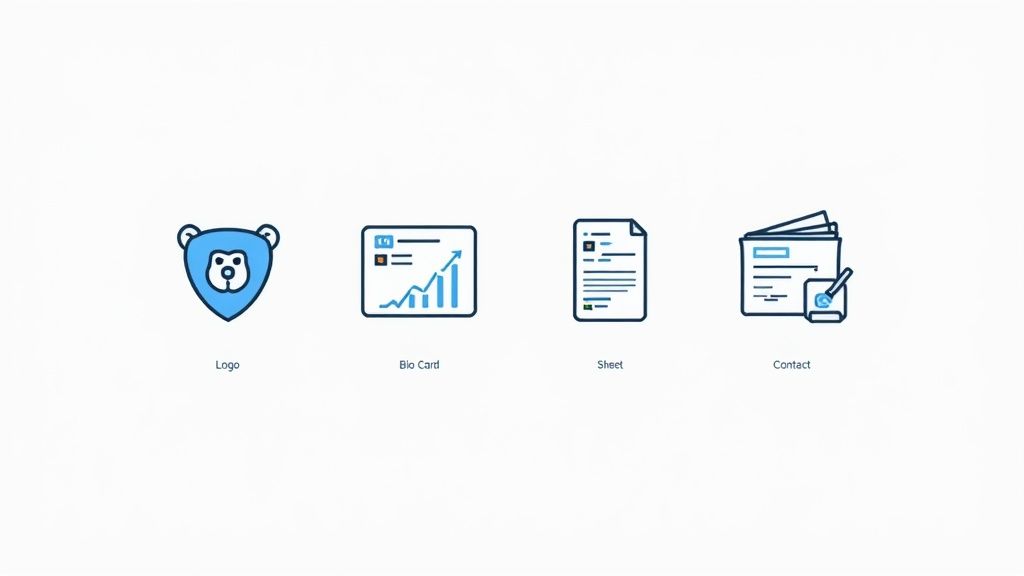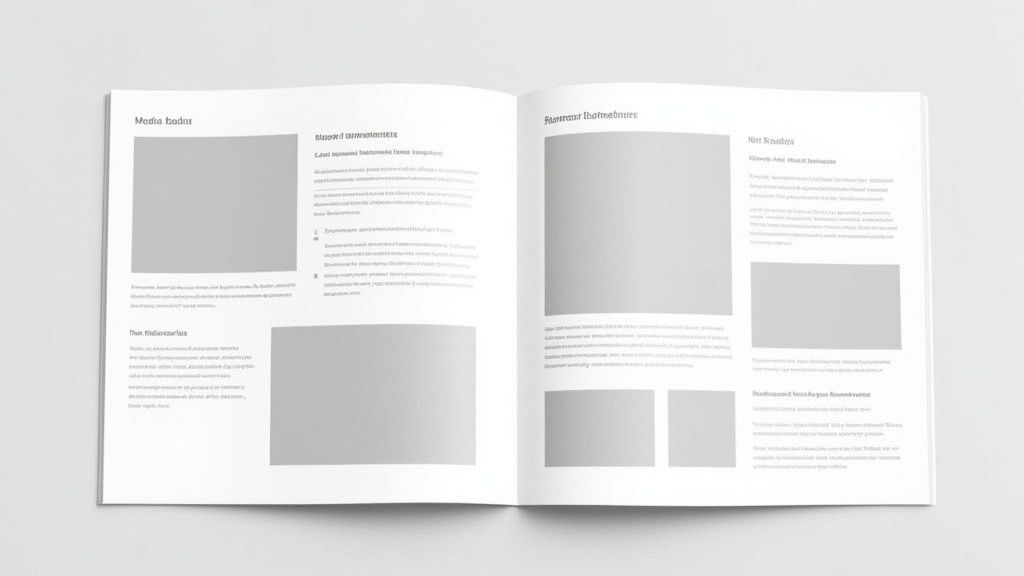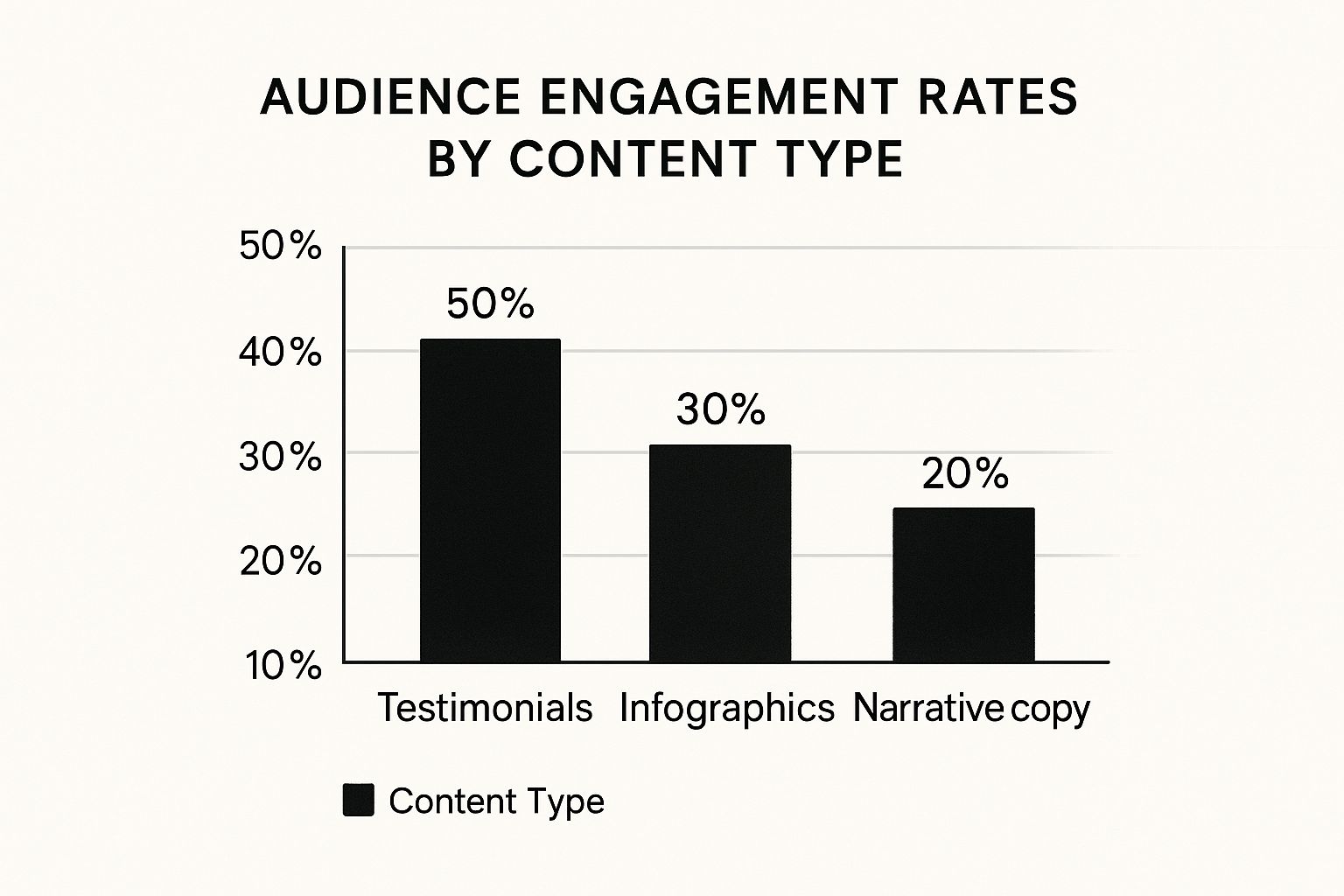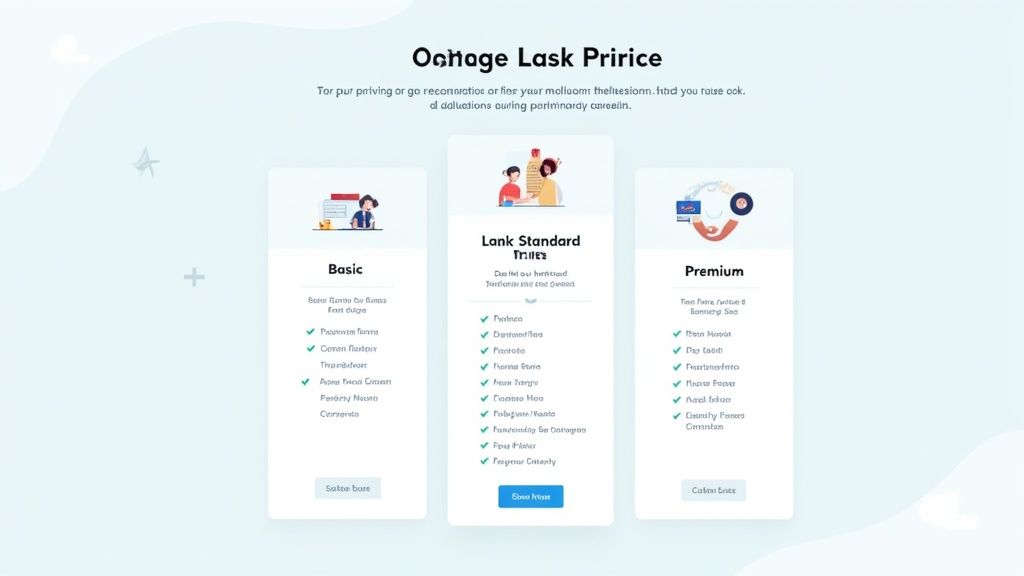
How to Create a Media Kit That Actually Lands Partnerships
Published
Why Most Media Kits Fail (And What Actually Works)
Let's be honest, most media kits just don't cut it. I've chatted with partnership managers at big brands, and they're not swayed by massive follower counts or pretty PDFs. What they actually crave are solutions to their business problems. The creators who consistently snag those sweet partnerships get this – they present themselves as strategic allies, not just content creators.
This means flipping the script on how you build your media kit. Ditch those generic templates that scream "I'm new here!" Instead, showcase your unique value. Think of your media kit as a powerful business proposal, not just a fancy resume. What special skills and audience insights do you bring to the table? How can you help a brand achieve their goals?
Let's say a skincare brand wants to connect with Gen Z. A creator with a dedicated Gen Z audience and a history of boosting sales for similar brands is way more attractive than someone with a bigger, but less focused, following. Quality trumps quantity, every time. This targeted approach fits perfectly with the move towards digital media kits, highlighting the importance of precise and relevant information.
It's interesting to see how media kits have changed over time. Back in the 1990s, they were mostly physical. Now, 80% of media kits are digital, and 93% of businesses use them for media outreach. It's a whole new world! Discover more insights.
At the end of the day, your media kit should answer one key question: *Why should a brand choose you? Show them you understand their business, prove you can deliver results, and position yourself as the obvious choice. Want to dive deeper into influencer marketing? Check this out: How to Get Into Influencer Marketing. Building a strong media kit is a game-changer for your influencer career, and it all starts with understanding what brands really want.
The Numbers That Actually Move The Needle
Forget vanity metrics. While some creators are still obsessed with follower counts, the pros who consistently land brand partnerships know the real deal: engagement quality, audience purchasing behavior, and conversion data. I've seen it myself – a creator with a smaller, highly engaged audience can totally outperform mega-influencers when it comes to driving real results. It's about quality over quantity.
So, how do you show brands you're the real deal? Start by digging into your analytics. Don't worry, you don't need fancy, expensive tools. Most platforms, like Instagram, offer basic audience demographics and engagement insights. For example, look at your average engagement rate on your posts and stories. Are people commenting, sharing, and saving your content? That kind of active participation is what catches a brand's eye.
Also, think about metrics that match what brands want to achieve. Let's say a brand wants to boost sales for a new product. If you can show them past campaigns where you successfully drove conversions for similar products, you're golden. This doesn’t mean you need to have worked with huge companies. Even smaller partnerships offer valuable data points. For a deeper dive into calculating your impact, check out this article on Influencer Marketing ROI.
Knowing your audience is key. Age range, location, and interests are essential, but dig deeper. What are their pain points? What motivates them to buy? This granular data helps brands see how your audience aligns with their target market. This is especially important now, with content marketing and audience engagement being so crucial for effective media kits. In fact, a whopping 63% of marketers globally stress the importance of showing off content performance metrics in their media kits. Want to learn more? Discover more insights.
Ultimately, presenting your numbers well in your media kit is about telling a story. Don’t just list stats. Connect them to real business value. Show how your engagement translates to brand awareness, leads, or sales. By focusing on the numbers that actually matter, you'll position yourself as a valuable partner, not just another creator with a big following. This strategic approach will help you stand out and create a media kit that truly resonates with brands.

Design Choices That Command Respect
Your media kit's visual appeal makes a statement before anyone even reads a word. There’s a big difference between just looking polished and looking like you get influencer marketing. Creators who consistently land amazing partnerships know that smart design choices are key. They use design to strengthen their brand and create a kit that brand managers actually want to read.
Think about visual hierarchy. Just like a well-designed website, your media kit should guide the reader's eye. Use headings, subheadings, and white space effectively. Bolding key stats like your engagement rate or niche can highlight what matters most. Pick a color palette that matches your brand. This creates a cohesive, professional look.
Imagery is essential. High-quality photos that showcase your content and personality are non-negotiable. Ditch generic stock photos or blurry images. Choose visuals that reflect your unique brand and the value you offer. If you're a food blogger, include stunning photos of your dishes! A fashion influencer? Showcase your style with professional photos.
Multimedia is now a must-have. In 2025, 68% of media pros expect high-res visuals and 82% prefer videos in media kits. Discover more insights. This shift towards multimedia shows how brands are changing how they communicate. Your media kit should be as engaging as your social media content.

Good design isn't just about pretty pictures; it’s about communicating your value. Think about how each design element reinforces your brand and shows the reader why they should partner with you. A well-designed media kit screams credibility, makes a strong impression, and helps you stand out, boosting your chances of landing those dream collaborations.
Core Sections That Drive Partnership Decisions
Every successful influencer media kit has a few key sections. But honestly, it's how you present them that really makes a difference. I've seen amazing media kits fall flat and simple ones land incredible deals. It all comes down to knowing what brands truly care about.
The Bio: More Than Just an Introduction
Your bio needs to do more than just introduce you; it should position you as the go-to person in your niche. Instead of listing accomplishments, tell your story. What gets you excited? What unique perspective do you bring? For example, if you focus on sustainable travel, share that passion and how it shapes your content. A good template can help you present this professionally. I've found this influencer media kit template super helpful in the past.
Case Studies: Show, Don't Just Tell
Anyone can say they deliver results. You need to prove it. Include case studies that show the real impact of your work. Did you boost sales for a brand? Increase their awareness? Use numbers to back up your claims. For example, mentioning a 15% increase in foot traffic for a coffee shop after your Instagram campaign is way more convincing than just saying you "helped them grow."
Collaboration Opportunities: Paint a Picture
Don't just list services—offer collaboration packages. This helps brands picture working with you. Different tiers with varying levels of involvement work well. Think: a sponsored post package, a brand ambassador package, and so on. This gives brands options and makes it easier for them to see where you fit into their strategy.
Pricing: The Delicate Dance
Pricing is always tricky. You want to showcase your value without scaring brands away. Package pricing or project-based rates can add transparency. Being open to custom packages also shows you’re flexible and willing to work with brands, not just for them.

This infographic shows how different content types impact audience engagement. Testimonials, for instance, drive 50% of audience interaction, compared to 30% for infographics and 20% for narrative copy. This highlights the power of using varied content, especially testimonials, both in your media kit and your overall content strategy.
Past Partnerships: The Balancing Act
Highlighting past collaborations builds your credibility. But be smart—respect confidentiality agreements! Focus on the types of brands you've partnered with and the positive outcomes, without spilling sensitive details. This shows you're experienced and trustworthy.
To help you figure out which sections are most critical for different types of partnerships, I've put together this handy table:
Essential Media Kit Sections by Partnership Type
This table compares the essential sections you'll need for different kinds of brand collaborations.
| Section | Sponsored Content | Brand Ambassador | Product Review | Event Partnership |
|---|---|---|---|---|
| Bio | Essential | Essential | Essential | Essential |
| Case Studies | Highly Recommended | Essential | Recommended | Recommended |
| Collaboration Opportunities | Recommended | Essential | Optional | Highly Recommended |
| Pricing | Essential | Essential | Recommended | Essential |
| Past Partnerships | Recommended | Highly Recommended | Recommended | Optional |
| Testimonials | Highly Recommended | Highly Recommended | Essential | Recommended |
| Audience Demographics | Essential | Essential | Essential | Recommended |
| Contact Information | Essential | Essential | Essential | Essential |
As you can see, while a strong bio, pricing, and contact info are universally important, other sections become more or less critical depending on the partnership type. For example, testimonials are crucial for product reviews as they build trust and credibility, while case studies demonstrating past success are key for securing brand ambassador roles.
Putting it All Together
By focusing on these core sections and tailoring them to the specific brands you're targeting, your media kit will become more than just a document—it'll be a powerful tool that helps you land those dream partnerships.
Getting Your Kit In Front Of Decision Makers
Creating a killer media kit is only half the battle. Getting it into the right hands is where the real magic happens. Influencers who consistently land partnerships are pros at strategic distribution. They know where the opportunities are, how to write outreach emails that grab attention, and when to follow up (without being annoying).
So, where do you even begin? First, identify legitimate partnership opportunities. Don’t waste your time contacting every single brand out there. Focus on the ones that truly align with your niche and values. For example, if you’re a fitness influencer, partnering with a fast-food chain probably isn't a great fit. A sportswear brand or a healthy meal prep service? Now that’s more like it. Your media kit is key to driving these partnership decisions. Need some inspiration? Check out these influencer media kit examples.
Crafting The Perfect Pitch
Once you’ve identified potential partners, crafting the perfect outreach message is your next move. Personalization is more than just inserting the company's name. You actually need to research the brand. Understand their current campaigns, their target audience, and their overall brand message. Then, position your media kit as the solution to their specific problems.
Let’s say a brand is struggling to connect with millennials. In your outreach, highlight your millennial audience demographics and showcase past campaigns where you successfully engaged this demographic. Show them exactly how you can help.
Timing Is Everything (and so are subject lines)
Timing is also crucial. Sending your outreach during a brand's big product launch or campaign might mean it gets lost in the shuffle. Try reaching out during quieter periods when they’re more likely to actually read your proposal.
And while we're on the topic of getting your email read…let's talk subject lines. "Increase Your Millennial Engagement by 20%" is way more compelling than a generic "Collaboration Proposal," right?
The Art of the Follow-Up
Following up is essential, but don't bombard people's inboxes. A well-timed follow-up a week or two after your initial outreach is usually sufficient. Keep it short, reiterate your value, and reaffirm your interest. For more tips, you might find this helpful: Influencer Marketing Best Practices.
Beyond direct outreach, remember the power of relationship building. Engage with brands on social media, comment on their posts, and show genuine interest in what they do. This keeps you on their radar and sets the stage for long-term collaborations.
Let's talk about distribution channels for a second. I've tracked my own outreach and compiled the data into a table to show what's worked best for me. Keep in mind, your mileage may vary, but this should give you a solid starting point.
Table: Media Kit Distribution Channels and Response Rates
| Distribution Method | Response Rate | Partnership Conversion | Best For |
|---|---|---|---|
| Direct Email | 15% | 5% | Established Brands |
| Instagram DM | 25% | 8% | Smaller Brands, Startups |
| Twitter DM | 10% | 3% | Tech Companies, News Outlets |
| Networking Events | 40% | 20% | Building Initial Connections |
| Influencer Platforms | 20% | 7% | Finding a Wide Range of Opportunities |
As you can see, networking events have been the most effective for me in terms of actually securing partnerships. However, Instagram DMs have the highest response rate. The key takeaway? Diversify your approach!
By combining strategic targeting, personalized outreach, and smart follow-up, you’ll transform your media kit from a static document into a powerful partnership-generating machine.
Keeping Your Kit Fresh and Partnership Ready
A static media kit is a deal-breaker. It's like showing up to a party with a week-old casserole – no thanks. The influencers who consistently land the best partnerships treat their media kits like living, breathing documents. They adapt and evolve right alongside their brand and the ever-changing market.
This means regularly updating your kit without constantly starting from scratch. My trick? A system. I use a shared Google Doc to track updates and revisions, with dedicated sections for recent campaigns, updated stats, and fresh testimonials. Easy access and easy collaboration.
Seasonal tweaks are also important. Let's say you're a fashion influencer. Your fall/winter kit should look totally different from your spring/summer one. Highlighting that seasonal relevance shows brands you're proactive and understand their needs. This is especially important since content marketing is still king, with 63% of marketers globally focusing on showcasing those all-important content performance metrics.
But updates shouldn't just be about looks. They should be performance-driven. Think of it like A/B testing your social media posts. Experiment with different versions of your kit and see which ones get the best response. I've learned so much just by asking brands what they liked best about my kit. Direct feedback is gold. Once your media kit is polished and ready, it's time to get it seen. Social media marketing can be a powerful way to promote it to the right people.
What to Update (and When)
Some things need more frequent love than others. Follower counts and engagement rates? Refresh those monthly, maybe even weekly if you're seeing fast growth. Case studies and testimonials? Update them after each successful campaign. Your bio and core brand messaging, on the other hand, should stay pretty consistent.
Tracking What Works
Knowing what's working in your kit is key. That’s where tracking comes in. I use trackable links in different sections of my kit to see what brands are clicking on. It tells me what's grabbing their attention and what might need a little work. It’s all about using data to make your kit the best it can be.

Knowing when to do a full revamp versus a quick refresh is important too. A big branding change or a shift to a new niche? Definitely time for a total overhaul. But most of the time, smaller, regular updates are more effective and keep your kit relevant. By constantly refining and adapting, you’re showing potential partners that you’re professional and always putting your best foot forward.
Your Partnership Success Action Plan
So, you’ve absorbed all this media kit wisdom—now let's make it work for you. This action plan will be your guide, whether you're building your first media kit or giving your current one a refresh. The goal? A media kit that consistently lands you those dream brand partnerships.
Timeline and Prioritization
Let's be real, crafting a killer media kit isn't an overnight thing. If you're starting from scratch, give yourself two to four weeks. Concentrate on the essentials first: your bio, key stats, audience demographics, and a couple of strong case studies. Then, you can dive into the design and figure out how you'll share it with the world.
Already have a media kit? A week of focused work can do wonders. Prioritize updating your stats, showcasing recent collaborations, and making any design tweaks to keep it looking sharp.
Action Steps for Maximum Impact
- Deep Dive into Your Analytics: Set aside a day to really get to know your numbers. What are your audience demographics? How’s your engagement? Which content is performing best? Google Analytics is your best friend here.
- Craft Your Narrative: Spend a few days crafting a compelling bio. Highlight your accomplishments and clearly define your niche. Think about what makes you you and let that shine through.
- Gather Visual Assets: Carve out some time to collect high-quality images and videos. These should showcase your work and reflect your brand's personality. Think eye-catching and professional.
- Design with Purpose: Dedicate a day or two to the visual presentation. A clean, professional design that aligns with your brand is key. Canva is a great resource for easy-to-use templates.
- Outreach Strategy Session: Brainstorm a list of brands you'd love to work with. Draft personalized outreach messages for each one and map out a follow-up plan. Don’t be afraid to get specific!
Measuring Your Success
Don’t just throw your media kit out there and hope for the best. Track the metrics that matter: media kit views, outreach response rates, and the number of partnership conversations it generates. These are direct indicators of how well your media kit is working. Low views? Rethink your distribution strategy. Low response rates? Tweak your outreach messages.
Troubleshooting Common Roadblocks
Pricing and design are two areas where creators often get stuck. For pricing, start simple and adjust as you gain experience and conduct market research. There are tons of free templates and online resources for design. And don’t hesitate to ask fellow creators or even potential partners for feedback. Their perspectives can be invaluable.
Checkpoint Goals and Motivation
Break the process down into smaller, manageable goals. Celebrate each milestone, whether it's finishing your bio, finalizing the design, or sending your first outreach email. These small wins will keep you motivated and prevent you from feeling overwhelmed. Remember, your media kit is a work in progress. Continuously refining and adapting is the key to long-term partnership success.
Ready to land your dream influencer marketing gig? Influencer Marketing Jobs is a fantastic resource for connecting with top brands and exciting opportunities in the world of digital marketing. Go find your perfect role!